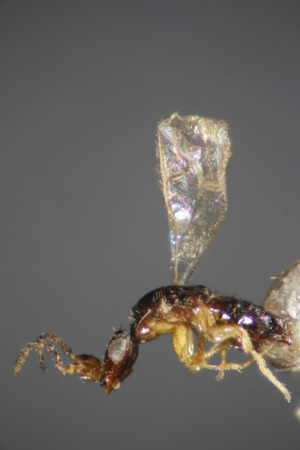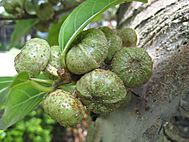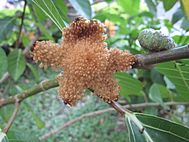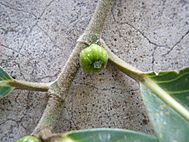Ficus septica facts for kids
Quick facts for kids Ficus septica |
|
|---|---|
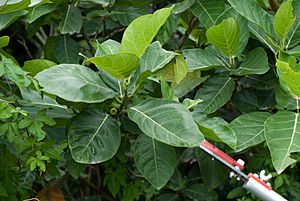 |
|
| The Hauli tree in Taiwan | |
| Scientific classification | |
| Genus: |
Ficus
|
| Species: |
septica
|
| Synonyms | |
|
List
|
|
The Ficus septica is a type of shrub or tree. People in the Philippines call it the hauli tree. In China and Taiwan, it is known as 稜果榕. This plant belongs to the Moraceae family, which also includes mulberries and breadfruit.
You can find the hauli tree growing in warm places. Its home ranges from northeast India all the way to northern Australia (Queensland). It also grows across Malesia, a region that includes countries like Malaysia and Indonesia. These trees often grow where other plants end, like at the edge of forests. They can also be found in areas where the environment has been changed by humans. Many animals help spread the seeds of the hauli tree. Fruit bats are especially good at this.
Contents
About the Hauli Tree
The Ficus septica was first described by a Dutch scientist named Nicolaas Laurens Burman in 1768. For a long time, scientists thought there were different types of Ficus septica. But later, a botanist named Cornelis Christiaan Berg said they were all the same species. He decided they should all be called Ficus septica.
What the Hauli Tree Looks Like
The hauli tree can grow quite tall, up to 25 meters (about 82 feet). When you cut the tree, you might see a yellow liquid called latex. This yellow latex is a special feature of the Ficus septica.
Its leaves are smooth and have a shape like an oval. The small stems that hold the leaves are also smooth. The figs, which are the fruits of the tree, often grow in pairs. Sometimes you might see just one fig, or up to four growing together. The figs are round and a bit flat. They have 7 to 12 ridges near the top. When the figs are ripe, they get whitish or yellowish spots.
Some hauli trees in the Philippines have short hairs on their stems. But the ones found in Taiwan usually have smooth stems.
Where the Hauli Tree Lives
Ficus septica trees can live in places up to 1800 meters (about 5,900 feet) high. They are found in mountain forests or in areas where new plants are growing after old ones were cleared. You can often spot them along rivers.
In Taiwan, which is the northernmost place where this tree grows, it lives at lower heights, up to 500 meters (about 1,600 feet). There, you can see it in new growth areas, along roads, and near the coast.
Life Cycle and Animals
The hauli tree has a special relationship with tiny insects called fig wasps. These wasps help the tree make seeds. They belong to a group called Ceratosolen. Usually, each type of fig tree has its own special fig wasp that pollinates it. But for Ficus septica, scientists have found something interesting. In southern Taiwan, there are three different kinds of fig wasps that pollinate it. In the Philippines, there are two different kinds.
Animals That Eat Hauli Figs
Many animals enjoy eating the figs from the Ficus septica tree. Scientists have seen 22 different animal species eating these figs. A large number of these animals, 14 of them, are bats!
- Double-eyed fig parrot
- Unspecified fruit dove
- Black-naped oriole
- Northern common cuscus
- Stein's cuscus
- Common spotted cuscus
- Mantled guereza
- Black rat
- Lesser short-nosed fruit bat
- Horsfield's fruit bat
- Greater short-nosed fruit bat
- Indonesian short-nosed fruit bat
- Bare-backed fruit bat
- Lesser naked-backed fruit bat
- Long-tongued nectar bat
- Long-tongued fruit bat
- Broad-striped tube-nosed fruit bat
- Common tube-nosed fruit bat
- Greater musky fruit bat
- Geoffroy's rousette
- Common blossom bat


